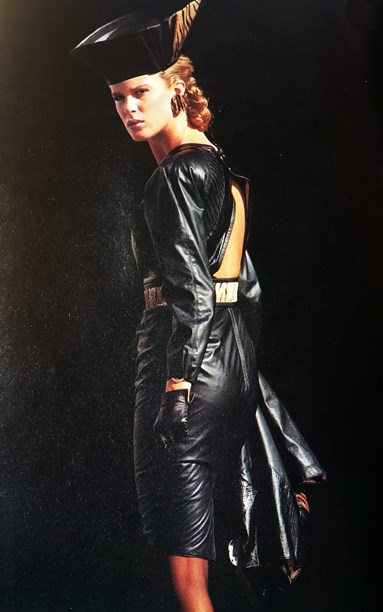Stories
Nita Henry
1960-

Nita Henry took the New Zealand fashion scene by storm in the 1980s with her detailed leatherwear ranges. Working as a seamstress from age 15 and also involved in the fashion industry as a model, the Christchurch based designer was making and selling leather garments under her own name into shops throughout New Zealand and Australia by the age of 21.
Zulu in Auckland, Wellington and Christchurch sold her designs exclusively while Quinns, Kimberley's and Caroline Moore were other local stockists.
Nita had worked as a furrier in Australia and always loved working with leather. She started by designing leather jewellery and then moved into clothing. Sourcing leather from Italy, Japan, Australia and New Zealand, Nita's approach was always unconventional. "I'm a real rule breaker," says Nita. "I didn't follow a standard formula. I wanted to do things that were unconventional and unique – that had never been seen before. That gave me the edge in fashion, by reaching out to a younger market that wanted to be rule breakers too."

Image © Nita Henry.
Nita remembers having to work hard to get leather accepted as a fashion item in New Zealand. "It was a new idea. I only got it into stores by supplying my garments on a sale or return basis, but once I got them on to the racks, my designs would be gone by the following week."
Throughout the 1980s and into the 1990s, the name, face and label of Nita Henry reflected nothing but success. The tall, confident designer was creating and overseeing the production of her own label’s ranges as well as designing several lines a year for the tourist trade. There were four full-time workers and four out-workers under her charge. Nita Henry garments were worn by Rachel Hunter and The Temptations, and even the Indian from the Village People.

Nita Henry entered this ensemble in the High fashion daywear category of the Benson & Hedges Fashion Design Awards in 1987. Image © Fashion Quarterly.
Nita was also setting records with her success in the Benson & Hedges Fashion Design Awards. She entered every show for more than a decade; and all of her famously detailed entries were accepted. In total, she received more than 20 nominations. Nita won the Menswear Award in 1993. She had a record six selections in 1994, four of which went on to be Highly Commended in the awards and one wool garment was given a High Distinction alongside the winner.
Two of Nita's entries in the 1994 Benson & Hedges Fashion Design Awards in 1994.
Then suddenly, in 1995, nothing. Not one entry. At the peak of her career, Nita Henry simply vanished from the fashion scene. What few people knew about the ambitious designer was that behind the successful facade, Nita was a woman quietly coping with illness.
Immediately following the break-up of her first marriage at the tender age of 21, Nita fell ill. Though it took many years to find a diagnosis, Nita was suffering from Crohn's disease, an inflammatory bowel disease where lesions in the digestive track cause intense pain and prevent the body from absorbing nutrients.
For 14 years she kept her illness quiet for fear of being perceived as ill or incapable. "I always put on a brave face and worked on," says Nita. During bed-ridden periods, when the slightest movement would trigger pain, Nita would draw or stitch the meticulous, labour intensive garments that she was famous for. "I was basically a workaholic. I would work through pain – I would just keep forcing myself because there was either deadlines or I just didn’t want to let people down."
But like many illnesses, Crohn’s disease is susceptible to stress. The frantic pace of the fashion industry - and especially the stress of competition - proved more than Nita’s fragile health could handle. Finally she had no choice but to accept it. "It’s a very hard thing to do, to suddenly just walk away when you’re at the height of your career." But Nita is philosophical. "I think that what this has done for me is it’s taught me a lot - and it’s also led me in another direction."
The fashion industry at the time was facing its own challenges. The government opened up tariffs on leather from China. Nita watched as tanneries she'd worked with folded overnight. Those two factors - her illness and the industry's challenges - led Nita to abandon her promising career at its apex.
Nita now lives in sunny Nelson, on a property covered in fruit trees and home-grown vegetables. She designs beads, scarves and copper healing bracelets and is working on a new range of leather jewellery. She works from a studio at home and has no staff.
Nita still follows fashion and admits that a small part of her still imagines a life in the industry, but says the New Zealand fashion world has changed enormously. In her time, patterns were made by hand, not by computer. Trends were discovered by travel, rather than web surfing. Materials were difficult to source. "We were so limited in terms of what we could get a hold of. You had to go overseas to the big shows and find suppliers."
Designers were completely dependent on bricks and mortar retailers – there were no online shops. "When I look back on the 80s and the 90s, I think that was a really special time in fashion. There was no internet. We were designing on the hoof, inspired by what was happening in music. It was the era of Madonna and Flock of Seagulls. I feel quite lucky to have been in that era and to have that be the height of my career."
Text by Kris Herbert.
Last published 2015.